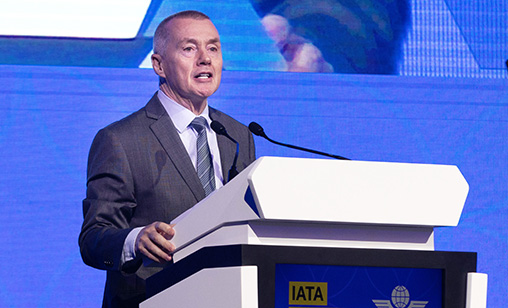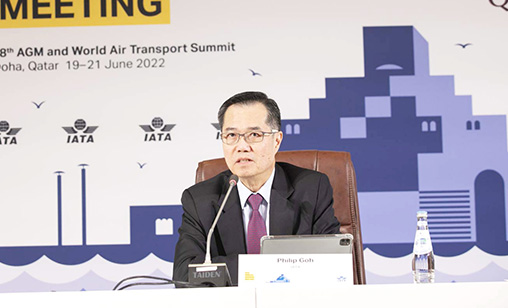Addendum
Asia-Pacific carriers to reach 90% of pre-COVID capacity in 2022
June 1st 2022
Asia-Pacific airlines, as a result of “strict and enduring travel restrictions, notably in China, along with an uneven vaccine rollout, have seen the region lag the in the recovery to date”, the International Air Transport Association (IATA) said in its updated financial outlook for the industry, released on the eve of its 78th annual general meeting and world transport summit, held in Doha mid-month. Read More »
The pace of recovery has quickened, the forecast stated, with losses narrowed to US$9.7 billion from an October 2021 forecast of $11.6 billion.
 |
“Industry-wide profitability in 2023 appears within reach, with North America already expected to deliver an $8.8 billion profit in 2022,” IATA predicted.
“Efficiency gains and improving yields are helping airlines reduce losses even with rising labour costs and a 40% increase in the world oil price and a widening crack spread this year.
“Strong pent-up demand, the lifting of travel restrictions in most markets, low unemployment in most countries and expanded personal savings are fueling a demand resurgence that will see global passenger numbers reach 83% of pre-pandemic levels in 2022.
“Additionally, cargo volumes are forecast to hit a record high of 68.4 million tones for the year.”
By next year, most markets should see traffic reach or exceed pre-pandemic levels, IATA director general, Willie Walsh, said in his keynote address to delegates and media at the Doha AGM.
In a fiery criticism of the management of the pandemic by governments worldwide, Walsh said: “COVID-19 was catastrophic. It robbed our world of millions of people – family, friends and colleagues. The responses of governments dismantled connectivity, destroyed jobs and inflicted misery on people, justified by politicians around the world that ‘their actions were driven by science’. George Bernard Shaw once observed that ‘science never solves a problem without creating ten more’. How true that is.”
Urging optimism for the industry, Walsh said that during the Global Financial Crisis [2008], travel patterns changed but passenger numbers held steady, with a quick return to growth from 2010.
 |
“And the decade that ensued delivered aviation’s strongest financial performance ever,” he said. “History repeats itself. We already see strong demand that will grow in the months and years ahead.”
In the IATA financial outlook, the importance of the China market, still largely closed to the world, was highlighted.
China’s domestic market accounted for 10% of global traffic in 2019. IATA’s forecast assumes a gradual easing of COVID-19 restrictions in the second half of 2022.
“An earlier move away from China’s zero-COVID-19 policy would, of course, improve the outlook for the industry. A prolonged implementation of the policy will continue to depress the world’s second largest domestic market and wreak havoc on global supply chains,” IATA said.
IATA vice president Asia & Pacific, Philip Goh, speaking at a regional briefing in Doha, said momentum is gathering pace in the Asia-Pacific, but many of the region’s governments were not keeping up with this “huge surge” for air travel.
“Japan is not opening as fast we would like,” he said, but added the industry has been advocating eased restrictions for entry into Japan and hoped the Japanese government will open the market in coming months.
People in the region learn quickly, Goh said. “Japan, Australia, New Zealand and Singapore are noted for preparing for a future industry that will be different from pre-pandemic times. Singapore in particular, has been at the forefront in the last half year of adapting to new customer expectations,” he said.
 |
“There is a need to raise awareness about changes in the industry, most importantly more widespread implementation of faster processing of passengers.
“The Asia-Pacific should plan for the huge upsurge ahead in pent-up demand and learn from Europe’s recent experience,” Goh said. “The industry must adopt more contactless travel to process passengers more quickly through airports. We need to speed up.”
IATA deputy director general, Conrad Clifford, said the airline association is urging governments to learn from the pandemic so “future global health threats can be effectively managed without closing borders”.
After two years of crisis, Clifford listed three lessons governments should take on board from COVID-19.
Evidence confirms border measures are not an effective global strategy to control a pandemic, he said.
Although total border closures and quarantine rules mostly have been removed and the world is increasingly open, complicated paperwork, COVID testing and compulsory mask wearing while travelling are still required in some jurisdictions, despite them being lifted in domestic life, he said.
Secondly, governments should conduct research to balance health measures with social and economic impacts “with a view to agreeing a global set of recommendations for handling future health crises”, he said.
Thirdly, “public confidence is adversely affected by arbitrary rules and poor and contradictory information”, Clifford said.
IATA recommends governments simplify, standardize and digitize travel bureaucracy and paper work and introduce mutual recognition of digital health credentials. There also should be clear guidance about the dismantling of public health measures after their introduction, Clifford said.
In a sobering conclusion to his keynote address, Walsh said: “the recovery from COVID-19 is coincident with a tectonic shift in geopolitics.
“The Russian invasion and subsequent war in Ukraine have shaken the foundations of globalization to which aviation has contributed, and that, in turn, enables so much of our business. … And the stakes in Ukraine could not be of greater consequence. That is why, even for our apolitical business-focused association, there cannot be any ambiguity in condemning what is happening in Ukraine. I am sure I speak for all participating in this assembly in calling for peace.”
armand kermani says:
May 1st 2025 04:57am